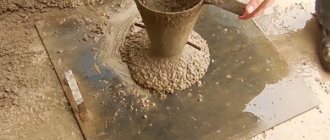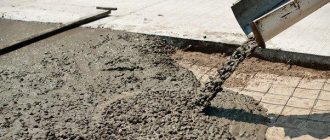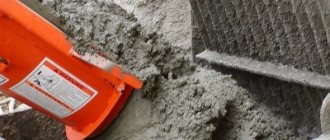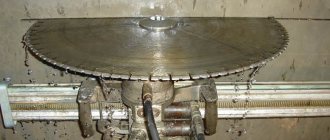It is well known that concrete is divided into different grades based on compressive strength and frost resistance. The workability of a concrete mixture is a parameter that is rarely paid attention to; Meanwhile, it greatly influences the process of monolithic concreting. Let's get acquainted with the relevant terminology and classification methods.
The workability of the mixture is important, among other things, when pouring a monolith with dense reinforcement.
What is the mobility of a concrete mixture?
Workability is characterized by mobility, which determines the presence of pores and voids in the thickness of the monolith. Pores and voids have a bad effect on the strength of products. Thus, only 2% of the volume of concrete mixture occupied by pores leads to a decrease in the strength of products by 10%. If the number of cavities is about 5%, then the strength will be reduced by 30%. Poor mobility can be partially leveled by vibration laying.
However, high mobility is not always the optimal solution. This is explained by the fact that the preparation of mobile mixtures requires the use of large amounts of water. Meanwhile, a significantly smaller volume of water is required to interact with cement (approximately 20% of the cement mass). Thus, the excess content of water, which does not react with the binder, serves as a source of pores in the body of the product, which in turn affects the strength. Also, too fluid a mixture may spill out through the formwork or seep through the gravel bed.
Symbol
A short designation is required when placing an order for concrete of a given quality. If concrete of a given composition is ordered, markings are not used.
The designation indicates the following data:
- Type of concrete (abbreviated)
- Strength class
- Workability grade based on cone draft
- Optional indicators - medium density grade, frost resistance, water resistance, other characteristics
Heavy concrete, strength class B20, workability grade according to cone draft P3, frost resistance 150 cycles, normal water permeability, waterproof at pressures up to 0.4 MPa
Determination of mobility
Methods for determining mobility are quite diverse and are regulated by GOST 10181.1-81. The most practical and fastest methods include cone settlement. A special shape is used for measurement - a truncated Abrams cone. The height of the cone is 300 mm, and the diameter depends on the size of the filler grains. For mixtures with coarse filler there is an enlarged cone, for the rest with a diameter of a smaller base of 100mm at the top and a 200mm diameter for the larger base.
To determine the brand of concrete mixture by its workability, the cone is filled in 3 passes, tamping each layer with a bayonet. That is, the mixture is compacted with a metal rod to reduce the number of voids - each layer is compacted exactly 25 times. Excess concrete is cut off. After this, the cone is removed and installed nearby, and the molded concrete mixture settles under its own weight. The assessment of mobility is determined by the amount of its settlement in centimeters. For mixtures in which no cone settlement occurs, the hardness is determined.
What is needed to determine characteristics
There are several methods to obtain the test result. At the same time, workability is not directly determined by any of them. After all, the concept itself remains conditional. For different concretes, this property results in either rigidity or mobility. But several common instruments have been developed to obtain more or less accurate results.
- Cone slump is a method for testing concrete, relevant in the case of moving mixtures with low rigidity.
A special pouring mold is used, which is filled with materials. The main device is shaped like an Abrams cone.
The main material for the manufacture of such cones is sheet steel up to 300 millimeters high. The lower base will be 200 millimeters. The diameter of the upper base is 100. The installation location is a sheet with a fairly smooth surface. A metal rod is used for compaction. Including when we mean the Abrams cone.
- A technical viscometer is another device that is used in the case of rigid compounds.
The device is formed by metal molds and a vibration platform that has certain characteristics. For example, the amplitude of vibrations at the site itself is 0.35 millimeters. 2800-3000 is the approximate number of oscillations typical for most situations.
Standard cones are placed on the platform, and material is poured into them. They cannot do without metal bayonets used during pressing. Vibration action is necessary to finally secure the positions of the material.
- A simplified version of measurements is used in the case of solutions of high hardness.
The same vibration platform is used, but a metal cube-shaped form is mounted on it. Standard cones are installed inside the mold.
Determination of hardness
Rigidity, unlike mobility, is assessed not in centimeters, but by the time it takes to fill the mold with the mixture under the influence of vibration. To determine this parameter, a cylindrical shape is installed on the vibrating plate, into which a conical shape is placed. The conical shape is filled with concrete mixture, compacted by bayonet. After removing the cone, carefully install a disk with six holes onto the formed mixture. The disk is pre-secured in the tripod using a bushing. After this, the vibrating platform is turned on and the time required to fill the cylinder with the mixture and compact it is determined. The completion of the test is judged by the appearance of cement laitance from at least two holes in the cylinder.
What is cone draft?
Typically, the slump of a concrete cone is defined as a numerical designation, with centimeters as the unit of measurement. The indicator shows how much the concrete sinks after removing the cone and any other shapes. Thanks to this, within one classification group it is easier to separate one brand from another based on plasticity. For example, the mixture is definitely highly mobile if the shrinkage is more than 5 centimeters. Group P-3 includes materials with a concrete cone settlement of 10-15 centimeters. Next comes P4.
Concrete grades based on workability
GOST 7473-94 divides concrete mixtures depending on the workability parameter into:
- super-hard (marked SZh);
- hard (marking F);
- mobile mixtures (marking P).
The workability grade contains a number after the letter value. For example, the workability grade P5 says that this mixture is mobile, and its cone draft is more than 21 cm. The workability grade Z2 characterizes a rigid mixture that is compacted in the cylinder within 11-20 seconds.
Mobile concrete mixtures
P1-P3 refer to low-moving trains, P4-P5 – to trains with increased fluidity. Slow-moving trains are suitable for the construction of monoliths. Vibration is required to work with them. High-flow concrete is used if dense reinforcement interferes with compaction.
Rigid concrete mixtures
Rigid concrete mixtures contain a small amount of water and less cement compared to flexible concrete mixtures of equal strength. They require intense long-term vibration or vibratory ramming. The area of use of rigid concrete mixtures is the production of prefabricated concrete products.
Ultra-hard concrete
Ultra-rigid concrete is produced from SL mixtures using hydrothermal treatment technology. That is, after mixing, LF mixtures are compacted, passing from a loose state immediately to a solid state, bypassing the intermediate state of liquefaction. These mixtures are mainly used in technologies for the production of autoclaved concrete.
The strength of the structure being poured depends on the density of the mixture. For each specific purpose, its own mobility or rigidity of the building material is selected, which is regulated using cement and plasticizers.
Application
How does the workability grade of a concrete mix affect its typical applications?
| Application area | Recommended Brands |
| Concrete pads for foundations, floor screeds | P1, G1 |
| Road and airfield pavements, slab foundations with sparse reinforcement or without reinforcement | P1 |
| Slab foundations with moderate reinforcement density, beams | P1, P2 |
| Massive columns | P2 |
| Horizontal structures with dense reinforcement | P2, P3 |
| Vertical structures with dense reinforcement | P3, P4 |
| Floor slabs, pipelines | P5 |
Dependence of mobility on mixture composition
The mobility of concrete depends largely on the ratio of fillers. To change some characteristics, additives (plasticizers to increase fluidity) are introduced into the mixture. Ideal plasticity is obtained with the correct water-cement ratio. The more fillers and the lower the moisture content, the harder the mixture. An imbalance leads to a deterioration in the strength of the monolith. You cannot add water to a ready-made composition - this leads to undesirable separation of the mixture.
In general, the finished solution retains its characteristics unchanged for 2 hours after preparation. If longer storage or transportation is required, plasticizers are used that increase plasticity by up to 25%. The solution with plasticizer can be stored for up to 6 hours.
Factors affecting the mobility of solutions
The technological features of the concrete mixture determine its composition and the properties of the materials used.
Movable concrete
The extent to which changes in the characteristics of solutions will occur, and with what results, depends on the following factors:
- The higher the volume of cement paste, the more liquid its consistency will be, and the higher the mobility of the solution. Adding aggregates to the cement paste reduces the mobility in the following progression - the greater the composition of the aggregates and their specific surface area, the lower the mobility of the concrete.
- With a decrease in the amount of aggregates and an increase in the volume of cement paste, with a constant W/C, the mobility of the mixture increases, but the strength remains unchanged.
- The properties of cement significantly affect the workability of mortars. Concrete mortars containing pozzolanic Portland cement, especially with an active silica additive, at equal water consumption, have a significantly lower cone slump than concrete using ordinary Portland cement.
Pozzolanic cement
- Changing the amount of water is the main factor by which the consistency of the mixture is regulated. With an increase in the volume of water, with a constant amount of cement, the mobility of the solution increases, and the strength decreases.
- As the grain size of the aggregates increases, their impact on the cement stone decreases, and as a result, the mobility of concrete increases. Dust and clay components usually reduce workability.
- An important factor is the ratio of sand and crushed stone volumes. With an abnormal increase in these components relative to each other, the specific area of the aggregates increases and the mobility decreases.
In other words, in a concrete solution there is such a proportion between aggregate and cement, including a correspondence between crushed stone and sand, at which the structural viscosity of concrete will be minimal, mobility will be greatest, and a minimum of energy will be expended for its laying and compaction.
What is concrete used for?
Concrete is a basic building material. It is used for the manufacture of:
- prefabricated reinforced concrete and concrete structures;
- monolithic concrete and reinforced concrete structures.
When constructing objects using concrete, their types and grades are determined already at the design stage. For each element in building structures (in foundations, load-bearing walls, columns, piles, internal partitions, sanitary cabins, floors, swimming pools, etc.), types and grades of various concretes appropriate for the purpose must be used.
The scope of application of a wide range of concretes in modern construction is constantly expanding. The most promising are high-strength grades of concrete (heavy/light) and special concrete with special specified physical and technical values of certain parameters, such as:
- low draft and mobility;
- frost resistance;
- durability;
- resistance to possible cracking;
- increased heat resistance;
- protection of human bodies from the negative effects of penetrating radiation, etc.
Cone test method
A cone 30 cm high is installed on a sheet made of steel. The form is filled with three layers of mortar of equal thickness. Each layer is bayoneted 25 times with a special rod. Rod length 600 mm, cross-section 16 mm. Excess mixture protruding above the cone is removed. The cone is removed from the tripod within three to seven seconds without shaking. The difference between the upper cut of the cone and the surface plane of the settled concrete is measured. Based on this value, a conclusion is made about the degree of mobility (P).
The test is repeated and the final conclusion is made by obtaining the arithmetic mean.
The concrete mixture is assigned a mobility index (P) according to the cone settlement table (O.K), determined by GOST
In cases where it is impossible to carry out testing using the above method (in variants of hard and super hard classes), the second option is used.
Which concrete to choose for a strip foundation
Strip foundations are often laid when constructing low-rise buildings. The low load on the base allows you to replace the slab foundation under the entire area of the building with a tape running only along the perimeter. In this situation, a strict approach is required when choosing a class or grade of concrete for the foundation of a house in terms of strength.
The strip foundation is assembled from individual concrete blocks or poured with a monolithic strip. Assembling a foundation from blocks is practiced only in Russia; abroad, exclusively monolithic construction is used. This state of affairs is due to the low technological level of concrete work in domestic conditions and a number of other shortcomings.
According to GOST 13580-85, heavy concrete of medium density (2200–2500 kg/m3) is used for the construction of a strip foundation. The required strength class is from B10 to B25, the specific value depends on the width of the strip and the load-bearing capacity group.
In practice, it is permissible to use concrete with a density of 1800–2500 kg/m3. The strength class for preparation for a foundation is B7.5, B10 or B12.5, for the foundation itself - B15, B20, B22.5, B25, in difficult conditions - B30. Most often, customers buy concrete of strength class B15 (corresponding to grade M200).
Factors influencing the choice of ready-mixed concrete class:
- Manufacturer's integrity and correspondence of nominal characteristics to real ones
- Operating temperature and humidity
- Level of protection of the foundation from penetration of groundwater and atmospheric moisture
Concrete BST V15 P3 F100 W4 (corresponding to grade M200) is suitable for almost all conditions. If operation is envisaged at temperatures below −40 C° with cyclic freezing and thawing with constant water saturation, it is necessary to use concrete BST V20 P3 F150 W4 (corresponding to grade M250).
Important: you can be sure that concrete belongs to a specific brand only if you produce it yourself or order it from large suppliers with an established reputation. Taking into account the habit of saving cement by domestic producers, it is recommended to purchase concrete one or two strength grades higher than the design parameters.
Certain adjustments when choosing a strength class are made by the characteristics of soil heaving.
Selecting a class or brand of concrete for the foundation with a margin for cement savings by the supplier
| House type | Soil heaving | Strength class | Strength grade |
| Panel or frame | Slightly heaving | B15 | M200 |
| Heaving | IN 20 | M250 | |
| From timber or logs | Slightly heaving | IN 20 | M250 |
| Heaving | B22.5 | M300 | |
| Made from gas, foam or expanded clay concrete blocks | Slightly heaving | B22.5 | M300 |
| Heaving | B25 | M350 | |
| Made of brick or monolithic concrete | Slightly heaving | B25 | M350 |
| Heaving | B30 | M400 |
In the empirical table below, the strength is indicated for a one-story house. For a two- or three-story house, you need to choose a mixture of a grade higher, but not higher than M400.
Useful little things
In general, it is better to use plasticizing additives.
The corrugation of the reinforcement frame allows you to do without additional anchoring; Diamond cutting and drilling do not disrupt the adhesion between the reinforced frame and concrete due to the absence of impact vibration.
In addition: the edges of holes and openings when using a diamond tool will be much neater than when using a hammer drill and jackhammer.
The photo allows you to evaluate the quality of the cut edges.
Application of suitable grades of concrete for various construction projects
When constructing objects using an industrial method, ready-mixed concrete is used, which has the following markings given in the table:
When producing high-quality ready-mix concrete, strict dosing of the components of concrete mixtures occurs. This serves as a guarantee of the strength and durability of future buildings.
The cost of ready-mixed concrete is determined by the composition and proportions of the components.
Ready-mixed concrete is widespread and is becoming even more popular due to its use in monolithic buildings and structures. The main differences between concretes - reliability, seismic resistance, absence of technological seams, uniform shrinkage and low price - determine their use:
- when pouring walls and foundations using formwork, which allows obtaining strict forms of given monolithic structures;
- when creating floors made of concrete or reinforced concrete, reinforced with steel frames, providing increased resistance to loads;
- during the construction of hydraulic structures, including the production of a variety of swimming pools of any size and level of complexity;
- when used as a cushion under the road surface when laying roads of different sizes;
- during the construction of various platforms, concrete blind areas, sidewalks and garden paths.











